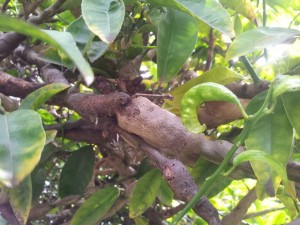A few days ago I stumbled upon this magnificent specimen, a lemon tree, pathetically deformed by gall.
The above picture shows a prime example of what happens when citrus gall wasp is left to go unchecked.
Seasons upon seasons of gall can be seen here.
The amazing vigour and resilience of citrus trees mean it is rarely too late to intervene.
Given, in this case external factors might be partly responsible for this extraordinary infection. It is my belief though, that half an hour of pruning a year on this tree would have made a huge difference to its sad faith.
This quite an upsetting sight, a bit like seeing someone who would let his or her dog go on with a flea infestation until it had scratched itself bald…
An extract about our friend Bruchofagus fellis from http://www.bugsforbugs.com.au/product/Citrus-gall-wasp-parasite
Citrus gall wasp Bruchophagus fellis
Adult citrus gall wasps are small shiny-black wasps about 2.5 mm in length. The adult wasps emerge around late September (later in southern districts). After mating, the females immediately lay eggs into the new season flush. Eggs hatch after 2 – 4 weeks and the young larvae burrow into the bark. Distinctive woody galls form around the larvae during summer. The new generation emerges the following spring, completing the year-long life cycle. Adult wasps live for only one week after emergence.
The strategy then, is two folded:
Don’t let the wasp hatch!
- Cut gall as soon as it can be seen. One quickly becomes an expert at identifying the swelling caused by gall. Citrus can be pruned all year, but remember that to stop the wasp’s life cycle, new galls have to be removed before mid august.
- Burn, microwave, irradiate, liquefy, drown or napalm pruned wood immediately. The wasp can still hatch if the cutting is left on the ground, or in the green waste bin.
- Fertilise, mulch, water. A healthy soil will promote a healthy tree.
- Check out http://www.bugsforbugs.com.au/product/Citrus-gall-wasp-parasite and import some natural parasites to your garden…
No eggs laid, no gall!
- Use companion planting to promote parasitic wasps that will help reduce the gall wasp population.
- Use Neem oil to repel the wasps. Works well for rodents and small animals ring-barking your trees.
- Foliage spray, with seaweed extract, once in a while. Or diluted worm castings/juice.
- Hang plastic drink bottles filled with 5-10 moth balls. Allow for aerating hole, but prevent water getting in. Hang in tree. A downside of this is that not only the wasp will be repelled, so will beneficial insects.
- I am not a fan of the sticky pads people use to catch the culprits. I have had looks at them many times, and found countless insects dead or dying on them, including rare native wasps and other beneficial insects, but have never seen a citrus gall wasp on one. Plus the sound of the insects little wings as they slowly perish is not my ideal of a background noise.
A bit more reading:
Interesting forum http://www.daleysfruit.com.au/forum/no-subject41/
Integrated pest management http://www.bugsforbugs.com.au/product/Citrus-gall-wasp-parasite




